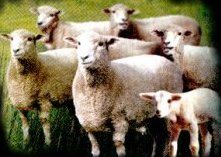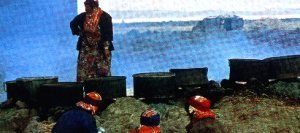 The use of vegetables, barko, roots and other natural
items to make dyes has been a well known art for many tousands of years.
this ancient practice continued unchanged and untouched untill the mid 19th.
century when synthetic dyes were invented. The findigs at a Chinese spring
dating from about 3000 B.C. inicate that the scince of dyeing was initially
devolpped in the far east. On the other hand, in Europe, the first dyers
were most probably people who leaved around Zurich Lake in about 2000 B.C.
The dyeing industry was established in the 15.th century B.C. We also know
that the art of dyeing belongs to old times in India. Marco Polo in the
cronicles of his travels tells us how Indigo was cultured before it was
exported to Europe by Portugeese to reach and varied Anotoilan dyeing proccesses
are a synthesis of the dyeing, the knowledge that was handed down from centuries
B.C., and the rich traditions of Anotolia itself. Why are natural dyes so
important? Is it because some shades of colour can not be found in various
synthetic dyes, or is it because the natural dyes are cheaper or easier
to obtain? The use of vegetables, barko, roots and other natural
items to make dyes has been a well known art for many tousands of years.
this ancient practice continued unchanged and untouched untill the mid 19th.
century when synthetic dyes were invented. The findigs at a Chinese spring
dating from about 3000 B.C. inicate that the scince of dyeing was initially
devolpped in the far east. On the other hand, in Europe, the first dyers
were most probably people who leaved around Zurich Lake in about 2000 B.C.
The dyeing industry was established in the 15.th century B.C. We also know
that the art of dyeing belongs to old times in India. Marco Polo in the
cronicles of his travels tells us how Indigo was cultured before it was
exported to Europe by Portugeese to reach and varied Anotoilan dyeing proccesses
are a synthesis of the dyeing, the knowledge that was handed down from centuries
B.C., and the rich traditions of Anotolia itself. Why are natural dyes so
important? Is it because some shades of colour can not be found in various
synthetic dyes, or is it because the natural dyes are cheaper or easier
to obtain?
Actually, its none of the seasons. The synthetic
dye catalogues are quite thick and rich in the kinds of dyes and shades
of colour that are available. But the natural dyes come from mother nature's
own harmony, and they reflect the preferences of the various peoples through
the years and centuries. Plus, the natural dyes (vegetable dyes) will mellow
with time, and if left under the sun, They'll shine and radiate the most
pleasing shades of colour.
In many areas it is common paractise to expose naturally
dyed rugs to the sun so that the colours fade gradially and gracefully to
the year ultimate harmony and beautiy. But the synthetic dyes dont have
this peculiarity. If the dye used is of the cromatic type, the colours are
fast to light, as well as moisture, which, in itself, can be considered
as an advantage. But if the synthetic dye used is of a lower quality, with
time the colours will fade and the various shades will probably be dull
and lifeles. We can see with our naked eyes all the differences in dyes,
understand the advantages, and disadvantages of each type, and easily discern
which ones are more harmonies and eye pleasing.
Fine Turkish carpets recognised for their value
and beuty are made with natural dyes obtained from plants, berries and trees.
Chemical dyes are also used but to the trained eye they do not have the
beauty or lustre of natural dyes. The main natural dyes are listed below.
Dyes Woad (Civit Otu) Blue: From this plant dark
or light blue tones are produced by the length of time which the plant is
boiled. It is found along the edges of fields groving wild in Central and
Western Anatolia. Dyers Woad and some other plants are used to yield indigo
which is the oldest and most important blue dye.
Madder Red (Kok Boya): The roots of this plant are
known as madder. It grows wild in Central and Western Anatolia. A two year
old plant will be about one and a half meters heigth . "Rose madder" was
a standart colour on the plattes of the old masters of the Rennaissance
and today, many expensive Itailan and English neckties are known as madder
ties because of the rich deep toned red colour.
Ox-Eye Camomile (Sari Papatya), Bright Yellow: During
the spring, one finds this plant all over Anatolia. It's large, golden yellow
flowers a top long stems last throughout the summer. It grows along roadsides
and in dry meadows. The flowers, fresh or dried, used along with an alum
mordant, produce a bright yellow.
Walnut Tree (Ceviz), Brown: The beatifull walnut
tree can be found in the forested country of Eastern Turkey. It is a profusely
branched tree which has a heigth of up to 25 meters and bears peanut leaves.
The fruit is covered with a thick green rind which along with the leaves,
is often used by villagers for a green or blackish-brown dye. The walnut
tree is native in Turkey and is absent only in the regions with several
meters. Turkey producs 15-20 percent of the world's wallnut crop. The effective
colouring agent is the brown dye, juglone, which adheres directly to wool
fibers without a mordant (mordant means a fixing agent). In ancient times
the wallnut pods were used in medicine and for the dyeing of hair.
Pomegranate Tree (nar), Yellow to bronish yellow
and brown to black: This tree grows in the mild regions of Western, Southwestern,
and Northeastern Anatolia. It's a tall tree with a heigth of up to 40 meters,
with branches that are spiny with very shiny, lance-shaped, dark green leaves.
It's easily distinguished by it's beatiful pinkish-violet flowers. During
autumn, the tree bears a fruit with many seeds which is the yellow-red skinned
pomegrate. The fresh or dried skin of the fruit is used for dyeing. If an
alum mordant is used, along with the skin, a yellow brownish shade will
result. If an iron mordant is used, a brownish-black shade will result.
In Oriental carpets and kilims, the pomegranete is a symbol of fertility
and abundance because of it's many seeds.
Buckthorne (Cehri), Deep Yellow: This plant grows
only in Turkey on slopes with altitude up to 3000 meters (9843 feet). Before
the 20th. century, it was mainly cutivated in Central Anatolia (Konya, Kirsehir,
Sivas, Ankara and Kayseri). To day only wild shrubs grow along roadsides,
in fields and vineyards at Urgup, Corum and Kahramanmaras, which are areas
of farmer cultivation. The unripe fruits, fresh or dried are used to create
the dyes. When an alum mordant is used, a deep yellow will result. This
deep yellow from the dried fruits is mainly used for dyeing silk. This colour
dye is ofen used to obtain secondary and tertiary colors.
 Supurge
(Sutlegen), Yellow: This plant grows throughout Turkey. The entire plants
contains a milky juice in its narrow, undivided leaves and clusters of blossoms.
Some variaties bloom during the late summer and early autumn. All parts
of the plant, except the roots are used for creating this yellow dye. This
dye is frequently detected in cottaged industry carpets of anatolia mainly
in the Daskiri, Maden and Ortakoy carpets. Supurge
(Sutlegen), Yellow: This plant grows throughout Turkey. The entire plants
contains a milky juice in its narrow, undivided leaves and clusters of blossoms.
Some variaties bloom during the late summer and early autumn. All parts
of the plant, except the roots are used for creating this yellow dye. This
dye is frequently detected in cottaged industry carpets of anatolia mainly
in the Daskiri, Maden and Ortakoy carpets.
Bast Hemp (Gence), Brilliant Yellow: This dye is
not used as ofen as other yellow dyes. This plant grows on the mountains
of Central and Eastern Anatolia. The brilliant yellow colour is common in
older flat weaves. The strong colour is often mistaken for a chemical dye
and for this reason it's not popular in Western anatolia Workshops where
weavers cater to foreign market. In Eastern Anatolia, Lake Van area, the
kilims are produced for local consumers who perefer bright colours and are
less concerned about the distinctions between chemical and natural dyes.
Wild Camomile (Beyaz Papatya), Yellow: During March,
in Western and Southern Anatolia, this camomine plant will cover entire
fields with fresh bolssoms. With alum mordant, a clear yellow dye will be
obtained.
 Tree-Leaved Sage (Ada cayi), Yellow: This herb can be found
in most Mediteranean regions. It blooms on the dry hill sides from March
up Until August. It is distintive its tall flowering spikes of mauve or
pinkish two-lipped flowers. The leaves and stams, either fresh or dried,
are sutible for dyeing. Plants are just one of many sources from which to
obtain natural dyes. To obtain a natural dye the plant is boiled to extract
the colour. Next, to ensure the absorption of the colour in to the wool
a second plant or natural salt is mixed with the dye. This second plant
or salt is known as the mordant. Tree-Leaved Sage (Ada cayi), Yellow: This herb can be found
in most Mediteranean regions. It blooms on the dry hill sides from March
up Until August. It is distintive its tall flowering spikes of mauve or
pinkish two-lipped flowers. The leaves and stams, either fresh or dried,
are sutible for dyeing. Plants are just one of many sources from which to
obtain natural dyes. To obtain a natural dye the plant is boiled to extract
the colour. Next, to ensure the absorption of the colour in to the wool
a second plant or natural salt is mixed with the dye. This second plant
or salt is known as the mordant.
A mordant prevents beeding or running of colours thus it fixes the colour.
If a chemical salt is used as mordant the dye is still called natural.
When alum is used as mordant alone with madder a pale red is obtained
because alum is a natural light salt. But if iron is used as a mordant
a deep red or burgandy is produced. The choice of modant determines the
colour of dye. Today, some people belive that there are no natural dyes
because of certain chemicals which are used as mordants. Mordants are
form from natural chemicals of the earth not synthetically produced, so
when they are added to natural dyes they act as a fixing agent and produced
the colour desired by the weaver.
|